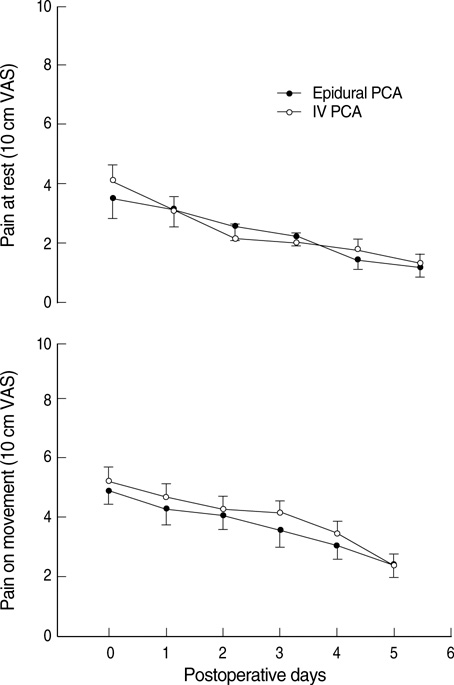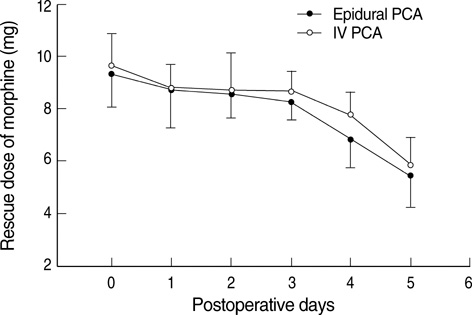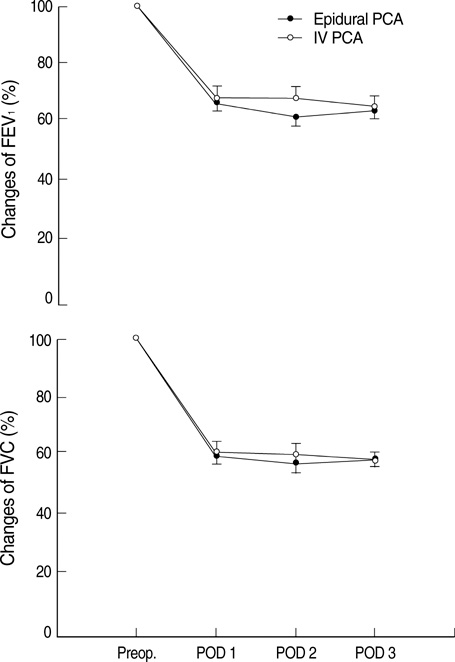Is Intravenous Patient Controlled Analgesia Enough for Pain Control in Patients Who Underwent Thoracoscopy?
- Affiliations
-
- 1Department of Anesthesiology and Pain Medicine, Samsung Medical Center, Sungkyunkwan University School of Medicine, Seoul, Korea. anesyang@skku.edu
- KMID: 1782017
- DOI: http://doi.org/10.3346/jkms.2009.24.5.930
Abstract
- This prospective randomized study was conducted to evaluate the efficacy of two common analgesic techniques, thoracic epidural patient-controlled analgesia (Epidural PCA), and intravenous patient-controlled analgesia (IV PCA), in patients undergoing lobectomy by the video-assisted thoracic surgical (VATS) approach. Fifty-two patients scheduled for VATS lobectomy were randomly allocated into two groups: an Epidural PCA group receiving an epidural infusion of ropivacaine 0.2%+fentanyl 5 microg/mL combination at a rate of 4 mL/hr, and an IV PCA group receiving an intravenous infusion of ketorolac 0.2 mg/kg+fentanyl 15 microg/mL combination at a rate of 1 mL/hr. Pain scores were then recorded using the visual analogue scale at rest and during motion (VAS-R and VAS-M, 0-10) for five days following surgery. In addition, we measured the daily morphine consumption, forced vital capacity (FVC), forced expiratory volume in 1 second (FEV1), satisfaction score, and the incidence of side effects. Thirty-seven patients out of 52 completed the study (18 in the Epidural PCA group, 19 in the IV PCA group). There were no differences in the pain scores, analgesic requirements, pulmonary function, satisfaction score, and the incidence of side effects between groups. This indicates that IV PCA and Epidural PCA are equally effective to control the postoperative pain after VATS lobectomy, which suggests that IV PCA may be used instead of Epidural PCA.
MeSH Terms
-
Adult
Aged
Amides/therapeutic use
Analgesia, Epidural/methods
Analgesia, Patient-Controlled/*methods
Analgesics, Opioid/therapeutic use
Anesthesia, Intravenous/methods
Anesthetics, Local/therapeutic use
Anti-Inflammatory Agents, Non-Steroidal/therapeutic use
Female
Fentanyl/therapeutic use
Humans
Ketorolac/therapeutic use
Male
Middle Aged
Pain Measurement
Pain, Postoperative/*drug therapy/prevention & control
Prospective Studies
Thoracoscopy
Figure
Cited by 3 articles
-
Opioid sparing effect of low dose ketamine in patients with intravenous patient-controlled analgesia using fentanyl after lumbar spinal fusion surgery
Sang Ho Kim, Soon Im Kim, Si Young Ok, Sun Young Park, Mun-Gyu Kim, Se-Jin Lee, Jung Il Noh, Hea Rim Chun, Haejin Suh
Korean J Anesthesiol. 2013;64(6):524-528. doi: 10.4097/kjae.2013.64.6.524.A comparison between ketorolac and nefopam as adjuvant analgesics for postoperative patient-controlled analgesia: a randomized, double-blind, prospective study
Ji-Seon Son, Aram Doo, Young-Jun Kwon, Young-Jin Han, Seonghoon Ko
Korean J Anesthesiol. 2017;70(6):612-618. doi: 10.4097/kjae.2017.70.6.612.The Effect of Nefopam on Postoperative Fentanyl Consumption: A Randomized, Double-blind Study
Jee Youn Moon, Sang Sik Choi, Shin Young Lee, Mi Kyung Lee, Jung Eun Kim, Ji Eun Lee, So Hyun Lee
Korean J Pain. 2016;29(2):110-118. doi: 10.3344/kjp.2016.29.2.110.
Reference
-
1. Nagahiro I, Andou A, Aoe M, Sano Y, Date H, Shimizu N. Pulmonary function, postoperative pain, and serum cytokine level after lobectomy: a comparison of VATS and conventional procedure. Ann Thorac Surg. 2001. 72:362–365.
Article2. Landreneau RJ, Hazelrigg SR, Mack MJ, Dowling RD, Burke D, Gavlick J, Perrino MK, Ritter PS, Bowers CM, DeFino J, Nunchuck SK, Freeman J, Keenan RJ, Ferson PF. Postoperative pain-related morbidity; video-assisted thoracic surgery versus thoracotomy. Ann Thorac Surg. 1993. 56:1285–1289.
Article3. Li WW, Lee RL, Lee TW, Ng CS, Sihoe AD, Wan IY, Arifi AA, Yim AP. The impact of thoracic surgical access on early shoulder function: video-assisted thoracic surgery versus posterolateral thoracotomy. Eur J Cardiothorac Surg. 2003. 23:390–396.
Article4. Nakata M, Saeki H, Yokoyama N, Kurita A, Takiyama W, Takashima S. Pulmonary function after lobectomy: video-assisted thoracic surgery versus thoracotomy. Ann Thorac Surg. 2000. 70:938–941.
Article5. Perttunen K, Nilsson E, Kalso E. I.v. diclofenac and ketorolac for pain after thoracoscopic surgery. Br J Anaesth. 1999. 82:221–227.
Article6. Kirby TJ, Mack MJ, Landreneau RJ, Rice TW. Lobectomy-video-assisted thoracic surgery versus muscle-sparing thoracotomy. A randomized trial. J Thorac Cardiovasc Surg. 1995. 109:997–1001.
Article7. Sentürk M, Ozcan PE, Talu GK, Kiyan E, Camci E, Ozyalcin S, Dilege S, Pembeci K. The effects of three different analgesia techniques on long-term postthoracotomy pain. Anesth Analg. 2002. 94:11–15.8. Miguel R, Hubbell D. Pain management and spirometry following thoracotomy: a prospective, randomized study of four techniques. J Cardiothorac Vasc Anesth. 1993. 7:529–534.
Article9. Richardson J, Sabanathan S, Shah R. Post-thoracotomy spirometric lung function: the effect of analgesia. A review. J Cardiovasc Surg (Torino). 1999. 40:445–456.10. Giebler RM, Scherer RU, Peters J. Incidence of neurologic complications related to thoracic epidural catheterization. Anesthesiology. 1997. 86:55–63.
Article11. Christie IW, McCabe S. Major complications of epidural analgesia after surgery: results of a six-year survey. Anaesthesia. 2007. 62:335–341.
Article12. Tajiri M, Maehara T, Nakayama H, Sakamoto K. Decreased invasiveness via two methods of thoracoscopic lobectomy for lung cancer, compared with open thoracotomy. Respirology. 2007. 12:207–211.
Article13. Craig SR, Leaver HA, Yap PL, Pugh GC, Walker WS. Acute phase responses following minimal access and conventional thoracic surgery. Eur J Cardiothorac Surg. 2001. 20:455–463.
Article14. Aygun S, Kocoglu H, Goksu S, Karaca M, Oner U. Postoperative patient-controlled analgesia with intravenous tramadol, intravenous fentanyl, epidural tramadol and epidural ropivacaine+fentanyl combination. Eur J Gynaecol Oncol. 2004. 25:498–501.15. Wu CL. Miller RD, editor. Acute postoperative pain. Miller's Anesthesia. 2005. Volume 2:6th ed. Philadelphia: Elsevier Churchill Livingstone;2732–2743.16. Glass PS, Estok P, Ginsberg B, Goldberg JS, Sladen RN. Use of patient-controlled analgesia to compare the efficacy of epidural to intravenous fentanyl administration. Anesth Analg. 1992. 74:345–351.
Article17. Coda BA, Brown MC, Schaffer R, Donaldson G, Jacobson R, Hautman B, Shen DD. Pharmacology of epidural fentanyl, alfentanil, and sufentanil in volunteers. Anesthesiology. 1994. 81:1149–1161.
Article18. Geller E, Chrubasik J, Graf R, Chrubasik S, Schulte-Mönting J. A randomized double-blind comparison of epidural sufentanil versus intravenous sufentanil or epidural fentanyl analgesia after major abdominal surgery. Anesth Analg. 1993. 76:1243–1250.
Article19. Vogt A, Stieger DS, Theurillat C, Curatolo M. Single-injection thoracic paravertebral block for postoperative pain treatment after thoracoscopic surgery. Br J Anaesth. 2005. 95:816–821.20. Hill SE, Keller RA, Stafford-Smith M, Grichnik K, White WD, D'Amico TA, Newman MF. Efficacy of single-dose, multilevel paravertebral nerve blockade for analgesia after thoracoscopic procedures. Anesthesiology. 2006. 104:1047–1053.
Article21. Ziser A, Messick JM, Schroeder DR, Allen MS. Requirements for postoperative analgesics in patients undergoing video-assisted thoracic surgery. The Internet Journal of Anesthesiology. 1999. 3(2):Available at http://www.ispub.com/ostia/index.php?xmlFilePath=journals/ija/vol3n2/vats.xml.
Article22. Furrer M, Rechsteiner R, Eigenmann V, Signer C, Althaus U, Ris HB. Thoracotomy and thoracoscopy: postoperative pulmonary function, pain and chest wall complaints. Eur J Cardiothorac Surg. 1997. 12:82–87.
Article23. Fernandez MI, Martin-Ucar AE, Lee HD, West KJ, Wyatt R, Waller DA. Does a thoracic epidural confer any additional benefit following video-assisted thoracoscopic pleurectomy for primary spontaneous pneumothorax? Eur J Cardiothorac Surg. 2005. 27:671–674.
Article24. Yoshioka M, Mori T, Kobayashi H, Iwatani K, Yoshimoto K, Terasaki H, Nomori H. The efficacy of epidural analgesia after video-assisted thoracoscopic surgery: a randomized control study. Ann Thorac Cardiovasc Surg. 2006. 12:313–318.25. Senagore AJ, Delaney CP, Mekhail N, Dugan A, Fazio VW. Randomized clinical trial comparing epidural anaesthesia and patientcontrolled analgesia after laparoscopic segmental colectomy. Br J Surg. 2003. 90:1195–1199.
Article
- Full Text Links
- Actions
-
Cited
- CITED
-
- Close
- Share
- Similar articles
-
- Comparison of Postoperative Analgesia and Side Effects by Patient-Controlled Epidural and Intravenous Analgesia after Cesarean Section
- Efficacy and Safety of Combined Subacromial and Intravenous Patient-controlled Analgesia after Arthroscopic Rotator Cuff Repair
- Continuous Subcutaneous Administration of Morphine Using Patient Controlled Analgesia Device for Control of Cancer Pain
- Can Different Analgesic Methods Affect Open Thoracotomy Outcomes?
- Comparison of Continuous Epidural Analgesia with Fentanyl-Bupivacaine Versus Intravenous Patient-Controlled Analgesia with Morphine for Postoperative Pain Control




